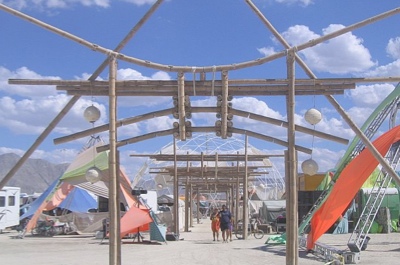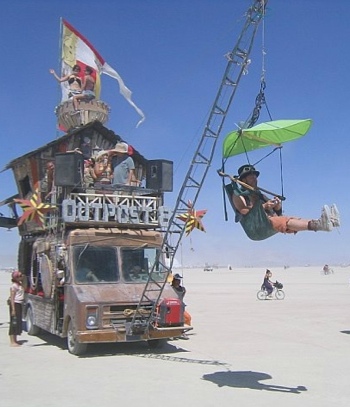Think the annual arts fest in the Nevada desert is nothing more than a week-long bacchanal? Think again. It's a a master class in how to create awesomeness.
It’s easy to dismiss Burning Man as nothing more than a bizarre hippie love-fest that takes place deep in the Nevada desert every year the week before Labor Day. But doing so misses the fact that it’s an amazingly successful enterprise--and, as such, has a thing or two to teach about how to inspire creative people and create a great product.
Since it first began 25 years ago, Burning Man has grown larger every year (if you ignore the slight dip in recession-scarred 2009). It’s grown so much that this year, for the first time ever, the organization had to cut off ticket sales early, for fear of finally hitting the 50,000-person limit authorized by its federal land-use permit. And those tickets aren’t cheap either--they now cost an average of $300 a pop.
Granted, Burning Man's overall intention is not to create a "product," per se. (Not one for trite labels, it calls itself an "experiment in community.") But its growth numbers--in terms of customers and revenue--are ones any business could envy. So how does Burning Man do it?
 It starts with culture
It starts with cultureOne of the first things to understand is that Burning Man isn’t actually just a festival. In many ways--in keeping with its mission--it’s actually more of a town. In fact, it's the 11th largest in Nevada during the one week of its existence.

The horseshoe that makes up "Black Rock City" (named for Black Rock Desert) gets delineated into "blocks" and "neighborhoods" where attendees (dubbed "participants") set up their camps--often elaborate compounds complete with sitting areas and play areas in addition to tents, yurts, and RVs. The "town" even has its own post office (send a letter and it will reach its destination, complete with a "Black Rock City" cancellation mark), as well as an airport.
As a result, many of the people who choose to go to Burning Man do so not just for the revelries and the festivities but simply because it’s a place they like to visit, like the Eastern seaboard, the Gulf Coast, Las Vegas, or the Poconos.
And they like to visit it because of the overall atmosphere. It’s one of the friendliest towns you will ever come across. Most camps have an open-door policy. You’re welcome to stop in at any abode. Most people are also inordinately helpful. Other Burners will happily help you set up your camp or install your art piece. And it’s amazingly safe for a town of 50,000, many of whom are partying for seven days straight. If you’re a woman, you can walk home at 3 in the morning with little fear of harassment. Brawls are basically unheard of.

So how does Burning Man produce this culture? It’s a mix of top-down instruction and horizontal transmission. The organization itself produces a Survival Guide that spells out the ethos of the place and the guidelines that make it work. And the organizers, in all their communications, consistently reinforce the event’s ethos. But truthfully, the most powerful part of the cultural transmission happens from person to person.
The group I joined when I first started going consisted of some guys who had belonged to one of the hardest-partying clubs in college. And yet these same guys were the ones who diligently instructed me on the importance of--and firmly held me accountable for--picking up and packing out every piece of trash larger than a sequin so that, after all Burners went home, the desert would be as pristine as it was before we all showed up.
How does this happen? Ultimately it comes down to the fact that Burning Man does a phenomenal job at communicating how the culture contributes to the overall experience. And since participants value the overall experience, they work hard to adhere to the cultural principles. And equally hard to pass those principles on to newcomers.
 Add a dose of trust and positive reinforcement
Add a dose of trust and positive reinforcement 
The other key component of how culture gets transmitted is through positive reinforcement, which itself is often bathed in a dollop of humor. There are no forbidding or bureaucratic signs at Burning Man telling you what you can and cannot do. Instead, where needed, signs are erected to remind attendees of things they might not know or might forget--but those signs are generally friendly and playful, like this one (right) reminding people not to bring their bikes (the main form of transportation) into a communal tent.
Organizers also imbue a huge amount of trust in the community. Volunteer Burning Man Rangers do patrol the town, but they’re there more to be of help than to lay down the law. Mostly, the organization communicates an attitude to the Burners that it trusts them to adhere to the communal rules and help propagate them.
All of which comes down to a fundamental principle of human nature: People want to be inspired, not lectured. They tend to respond better to humor and gentle reminders than they do to dictates or presumptions of guilt before innocence.

 Motivate with autonomy
Motivate with autonomyUnlike many festivals, Burning Man itself provides nothing more than the overall infrastructure—the city grid, the port-a-potties, the Rangers and other volunteers who keep the town running. But everything else is provided by the participants--the massive techno dance clubs, the yoga classes, the works of art, the merry little vehicles sailing across the desert, the makeshift restaurants, the seminars on technology and sustainability, the circuses, the chill spaces. Burning Man creates none of it. It all comes from the participants.
And the things the participants provide, which vary from year to year, are endlessly delighting and mind-blowing. A party bus outfitted to look like a giant rubber ducky. A “Mant Farm,” a three-story high human version of the old ant farms.

A go-kart retrofitted to look like a fighter jet. A vaudeville performance. A violin solo deep out on the Playa. A lounge-like oasis on the edge of the desert right where you'd need a break. A fire garden. A seminar on lucid dreaming. A bulletin board where people are encouraged to leave jokes (sample: “I saw a wino eating grapes. I was like, 'Dude, you have to wait a while.'"). A pirate bar where the occasional ninja shows up to wreak havoc (per the Internet meme). Even the 40-foot, eight ton rocket ship that has since taken up residence on San Francisco’s Embarcadero. You can spend seven days on the Playa and still not see all the marvels and wonders participants bring to the place.
So how does Burning Man get people to create such marvels? Not by command and control. The organization simply sets a few guidelines, mainly for safety purposes, and then gives attendees permission to let their imaginations run wild.
Not everything is a hit, of course. Every year there are any number of installations, performances, and activities that just don’t seem to hit the mark. But there are many more that overshoot it far more than if Burning Man had given specific instructions about what it wanted created.
This is a secret that organizations that successfully harness the imaginations of their creative people have long known: You can’t order creativity. You can only create the conditions for it to blossom--mainly by setting certain prescribed boundaries and then giving your creative people a great deal of autonomy to execute as they see fit.

Burning Man has a "no money" policy. Everything participants bring must be shared with other participants for free. (For an explanation of why, see "Decommodification" under the organization’s Ten Principles.)
So whether you just bring a set of hula hoops for people to play with, or a massive dance club costing tens of thousands of dollars to set up and run, you have to shell out all the money (and sweat equity) yourself, with no hope of ever recouping a dime for your troubles. Why would anyone do that, you might ask. The answer lies largely in Daniel Pink’s latest book Drive, which examines the science of human motivation (and how businesses often get it wrong).
Pink explains that you can’t motivate creative people with money. Certainly, you have to pay them enough to live on, he says, and pay them comparably to their peers so they feel appropriately valued. But after that, Pink explains, tossing more money at a creative person doesn't produce more creative output.
Instead, Pink says, creative people simply want the latitude discussed in the previous section (autonomy), as well as the opportunity to do something really well (mastery) and the opportunity to be part of something greater than themselves (purpose). And that’s what Burning Man provides.

No matter how whacky the thing bouncing around in your head (a party bus shaped like a duck, whowouldathought?), it will find a home and appreciation at Burning Man. And, more importantly, you will feel like you are doing your part to contribute to the overall experience. In fact, it's not unusual for newcomers--even those who felt slightly trepidatious about the whole enterprise to begin with--to leave the event toying around with ideas of what they might create to bring back the following year.
Much of the above probably sounds like common sense: Trust people and they will usually live up to that trust. Give people creative freedom, and they will surprise you with what they deliver. And indeed, it is common sense. And yet many organizations nevertheless fall down on one or more of these principles--structuring rules and regulations around a presumption of guilt on the part of employees, rather than treating them as trusted members of a community, or by offering only money rather than latitude in the effort to drum up creativity.
Burning Man, however, is a living example of how, when an organization lives by that sometimes not-so-common common sense, great things ensue.

[Images: Courtesy of E.B. Boyd; front page image by Mike Q. Victor]
Source: Fast Company
 Blog Gadgets
Blog Gadgets